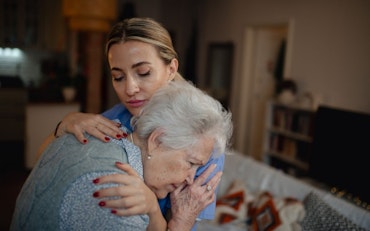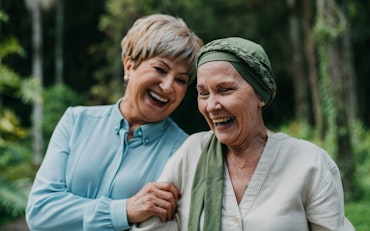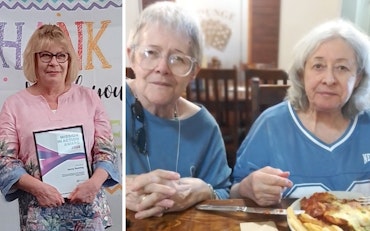Why women are more likely to have osteoporosis
Improving your diet and increasing exercise could reduce your risk of osteoporosis
![<p>Getting enough vitamin D in your diet can help bone density and reduce the risk of osteoporosis. [Source: Shutterstock]</p>](https://agedcareguide-assets.imgix.net/news/articles/wp/greyleg2603.jpg?fm=pjpg&format=auto&w=550&q=65)
Getting enough vitamin D in your diet can help bone density and reduce the risk of osteoporosis. [Source: Shutterstock]
Key points
- Around 20 percent of women over the age of 50 years old live with osteoporosis, which is a low bone-density disease
- The Royal Australian College of General Practitioners has released updated guidelines to help doctors make evidence-based recommendations for patients with osteoporosis
- Getting sufficient calcium and vitamin D in your diet can reduce your risk of osteoporosis
Around 20 percent of women over the age of 50 years old are currently diagnosed with osteoporosis, compared to just five percent of men who are the same age.
Osteoporosis is a chronic disease related to reduced bone density, however, due to its invisible nature, it may only be identified when a person fractures a bone.
Women are more likely to have reduced bone density as they age. Reasons for this include having smaller bones and a reduction in the oestrogen hormone during menopause, which helps with bone strength.
With so many women being affected by low bone density, creating appropriate treatments to minimise their risk and prevent further damage from osteoporosis is crucial. More research is required to achieve this, however, updated evidence-based guidelines have recently been made available to doctors to facilitate better treatment for Australians with osteoporosis.
Almost four percent of Australians in 2018 reported having osteoporosis or osteopenia, which is less severe. However, accurate numbers of Australians affected remain largely unknown as osteoporosis and low bone density can often go undiagnosed.
For people living with osteoporosis, fractures are likely to be a common occurrence as their bones become extremely fragile. Even with a small bump, a fracture could occur which can lead to disability, reduced quality of life and limited independence.
Additionally, older people with osteoporosis who experience hip fractures have ‘high levels of morbidity and increased mortality.’
The spokesperson for Royal Australian College of General Practitioners Professor Mark Morgan is confident that updates to the guidelines will ensure patients receive the best advice regarding their condition.
“The latest edition includes information on preventing first fractures, early diagnosis of osteoporosis that allows superior bone health management before a patient’s condition deteriorates, identifying the condition in undiagnosed patients following an initial fracture to prevent subsequent fractures and the management of secondary causes of poor bone health,” said Professor Morgan.
While the treatment guidelines will help doctors provide the most appropriate treatment for people with osteoporosis, reducing your risk will help ensure you stay in good health.
The president of the Royal Australian College of General Practitioners Dr Nicole Higgins wants Australians to increase their understanding of bone health to reduce their risk of osteoporosis and low bone density concerns.
“[…] Many people, including those over 50 years of age, should be aware of their bone health due to the extent of this health issue with Australians living longer and our ageing population,” said Dr Higgins.
Risk factors for osteoporosis include a lack of physical activity, insufficient dietary intake of calcium and low vitamin D levels.
Eating fresh fruit and vegetables can increase your dietary intake of calcium and vitamin D.
While many dairy products are full of calcium, other products with a high calcium content include almonds, leafy green vegetables and salmon.
Getting vitamin D from the sun is a good way to increase your vitamin D exposure but it’s important to still be sun smart. Foods that are high in vitamin D include fatty fish and fish liver oils. Smaller doses can be found in foods such as beef liver and cheese.
If you require higher doses of calcium and vitamin D to reduce your risk of osteoporosis, supplementation may be required. To get more information relevant to you about the most suitable products, have a conversation with your local pharmacist or doctor.
While diet is important, increasing your strength through weight-bearing exercises could positively reduce your risk of osteoporosis. However, if you do not regularly exercise or are over 75 years old, check with your doctor before starting any new exercise regime.
Weight-bearing exercises include jogging, tennis and brisk walking. While engaging in such exercises could minimise your risk of osteoporosis, there are countless other benefits to why a short walk could change your life.
If you are concerned or feel you may be at risk of low bone density or developing osteoporosis, discuss this with your doctor at your next appointment.
Do you have osteoporosis? How has this affected your life?
Let the team at Talking Aged Care know on social media.
For more information and news in the aged care industry, subscribe to our free newsletter.
Relevant content:
How one online resource has changed the game for seniors in NSW
Providers, indirect and direct care workers — how Stage Three will impact you










